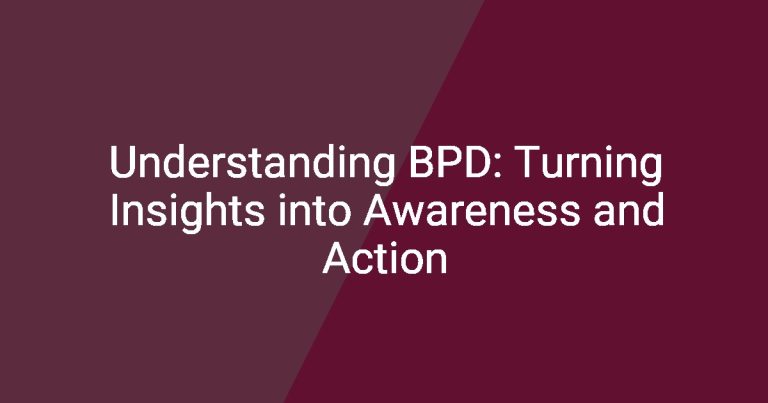Borderline Personality Disorder (BPD) is a complex mental health condition characterized by instability in emotions, self-image, and interpersonal relationships. Its significance in mental health cannot be overstated; BPD affects millions of individuals worldwide, shaping the way they interact with themselves and others. Understanding the types of BPD is crucial for effective treatment, diagnosis, and support, as each type presents unique challenges and symptoms.
Understanding BPD: Clinical Features
The clinical features of BPD manifest through distinct yet overlapping symptoms that can hinder daily functioning. The major characteristics include:
Emotional Dysregulation
Individuals with BPD often experience intense emotional responses, making it challenging to manage both positive and negative feelings.
Impulsivity
Impulsive behaviors, such as reckless driving or substance abuse, are common and can lead to harmful consequences.
Interpersonal Difficulties
Maintaining stable relationships can be a struggle, with individuals swinging between idealization and devaluation of others.
Identity Disturbances
People with BPD may have a distorted self-image, feeling like they do not know who they are or what they want.
General Types of BPD
Classic BPD
Classic BPD is characterized by the hallmark symptoms of the disorder. Individuals often display intense emotions and fear of abandonment. Treatment approaches include:
– **Therapy Options**: Dialectical Behavior Therapy (DBT) is widely recognized for its effectiveness.
– **Common Symptoms**: Mood swings, turbulent relationships, and self-harming behaviors.
Quiet BPD (or High-Functioning BPD)
Quiet BPD often involves more internalized symptoms compared to Classic BPD, manifesting as hidden emotional turmoil. Signs include:
– **Internalizing Emotions**: Individuals may suppress feelings, making it hard for others to recognize their struggles.
– **Fear of Abandonment**: A persistent concern that leads to anxiety and often affects personal relationships.
Coping mechanisms might focus on fostering emotional expression through safe avenues such as art therapy or journaling.
Chaotic BPD
Individuals with Chaotic BPD may experience significant disruptions in their lives. Major symptoms include:
– **Explosive Anger**: Sudden outbursts can occur, often triggered by perceived slights.
– **Self-Harm Tendencies**: Risky behavior and self-harm can be more pronounced.
This type can create turmoil in relationships, as others may feel confused and unsafe.
Discouraged BPD
This variant often presents feelings of hopelessness and inadequacy. Symptoms include:
– **Feelings of Emptiness**: Individuals may feel a lack of purpose or fulfillment.
– **Anxiety and Depressive Traits**: A tendency towards sadness is common, potentially requiring treatment that focuses on mood stabilization.
Treatment might incorporate CBT to address negative thought patterns.
Petulant BPD
Marked by a need for attention and validation, Petulant BPD is characterized by:
– **Manipulative Behavior**: Individuals may engage in behaviors designed to evoke specific reactions from others.
– **Mood Swings**: Frequent changes in emotional state can confuse those around them.
This type often leads to contentious relationships, as manipulative tactics can undermine trust.
Diagnostic Criteria for BPD
To diagnose BPD accurately, professionals refer to the DSM-5 criteria, which include pervasive patterns of instability in interpersonal relationships and self-image. An accurate diagnosis is vital in developing an effective treatment plan, but challenges arise when distinguishing between the various types of BPD, as symptoms often overlap or mimic other disorders.
Causes and Risk Factors for Different Types of BPD
The origins of BPD can be complex and multifaceted, influenced by various factors:
Genetic Predisposition
Studies suggest a hereditary component, indicating that individuals with a family history of BPD may be at higher risk.
Environmental Influences
Childhood experiences, including neglect and emotional abuse, can significantly impact the development of BPD.
Trauma and Adverse Childhood Experiences
Experiencing trauma can act as a severe risk factor, potentially leading to the development of different types of BPD.
Treatment Approaches for BPD
A combination of psychotherapy and medication management provides the most effective treatment for BPD.
Psychotherapy
Psychotherapeutic methods are foundational in treating BPD. Popular approaches include:
– **Dialectical Behavior Therapy (DBT)**: Focuses on building skills to cope effectively with stress and emotions.
– **Cognitive Behavioral Therapy (CBT)**: Aims to change negative thought patterns that exacerbate symptoms.
– **Schema Therapy**: Addresses deep-seated patterns and beliefs that shape behavior.
Medication Management
While there is no specific medication for BPD, several types can help manage symptoms:
– **Antidepressants**: Often prescribed to tackle underlying depression and anxiety.
– **Mood Stabilizers**: Useful for managing mood swings and irritability.
– **Antipsychotics**: Sometimes included in treatment to help with severe symptoms, such as paranoia or disassociation.
Support Systems
Having robust support systems in place enhances treatment efficacy:
– **Importance of Social Support**: Encouragement from friends and family can be life-changing.
– **Group Therapy Options**: Sharing experiences with others can foster a sense of belonging.
– **Family Therapy and Education**: Involving family can clarify misunderstandings and improve dynamics.
Coping Strategies for Individuals with BPD
Developing effective coping mechanisms is vital for those with BPD:
Self-Care Techniques
Focusing on self-care practices, such as regular exercise and nutrition, can significantly influence emotional health.
Mindfulness Practices
Incorporating mindfulness can help individuals become more in tune with their emotions and reduce impulsivity.
Building Resilience
Engaging in activities that promote mental toughness makes coping with challenges more manageable.
Summary Table: Key Features of Different Types of BPD
| Type of BPD | Main Characteristics | Common Symptoms | Treatment Approaches |
|---|---|---|---|
| Classic BPD | Emotional instability, fear of abandonment | Mood swings, self-harm | DBT, CBT |
| Quiet BPD | Internalizing symptoms, hidden struggles | Suppressed emotions, anxiety | Art therapy, journaling |
| Chaotic BPD | Impulsive behaviors, intense anger | Explosive anger, self-harm | DBT, group therapy |
| Discouraged BPD | Feelings of emptiness, depression | Anxiety, hopelessness | CBT, support groups |
| Petulant BPD | Need for validation, manipulative behavior | Frequent mood swings, conflict in relationships | DBT, family therapy |
FAQ
1. What is BPD?
Borderline Personality Disorder is a mental health condition marked by emotional instability, impulsive behavior, and difficulties in relationships.
2. Are there different types of BPD?
Yes, there are several types of BPD, including Classic, Quiet, Chaotic, Discouraged, and Petulant BPD.
3. How is BPD diagnosed?
Diagnosis typically involves a thorough clinical evaluation based on the DSM-5 criteria.
4. Can BPD be treated effectively?
Yes, with appropriate psychotherapy and medication management, many individuals with BPD can lead fulfilling lives.
5. What is the difference between Classic BPD and Quiet BPD?
Classic BPD often displays more overt emotional expressions, while Quiet BPD involves internalized and hidden emotions.
6. What role do support systems play in treating BPD?
Having a solid support system enhances treatment outcomes by providing emotional encouragement and practical assistance.
7. Is medication necessary for all types of BPD?
Not all individuals require medication, but it can be beneficial for managing specific symptoms.
8. What coping strategies can help with BPD?
Self-care, mindfulness practices, and building resilience through supportive activities are essential coping strategies.
9. How can family members be involved in treatment?
Family therapy and education can help family members understand BPD and improve communication.
10. Where can I find more resources on BPD?
Consider visiting authoritative mental health websites, such as the National Institute of Mental Health [NIMH](https://www.nimh.nih.gov) or the National Alliance on Mental Illness [NAMI](https://www.nami.org) for additional information and support.
The types of BPD represent a spectrum of symptoms and behavioral patterns, making understanding and distinguishing them vital for effective diagnosis and treatment. Seeking professional help is crucial, as many individuals can benefit from tailored therapeutic interventions and support systems to manage their symptoms and enhance their quality of life.







